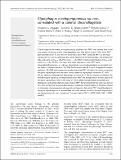Algoriphagus machipongonensis sp. nov., co-isolated with a colonial choanoflagellate
Author(s)
Alegado, Rosanna A.; Grabenstatter, Jonathan Dean; Zuzow, Richard; Morris, Andrea; Huang, Sherri Y.; King, Nicole; Summons, Roger E; ... Show more Show less
DownloadSummons_Algoriphagus machipongonensis.pdf (173.1Kb)
PUBLISHER_CC
Publisher with Creative Commons License
Creative Commons Attribution
Terms of use
Metadata
Show full item recordAbstract
A Gram-negative, non-motile, non-spore-forming bacterial strain, PR1[superscript T], was isolated from a mud core sample containing colonial choanoflagellates near Hog Island, Virginia, USA. Strain PR1[superscript T] grew optimally at 30 °C and with 3 % (w/v) NaCl. Strain PR1[superscript T] contained MK-7 as the major menaquinone as well as carotenoids but lacked pigments of the flexirubin-type. The predominant fatty acids were iso-C15 : 0 (29.4 %), iso-C17 : 1ω9c (18.5 %) and summed feature 3 (C16 : 1ω6c and/or C16 : 1ω7c; 11.3 %). The major polar lipids detected in strain PR1[superscript T] were phosphatidylethanolamine, an unknown phospholipid, an aminophospholipid, an aminolipid and two lipids of unknown character. The DNA G+C content was 38.7 mol%. Phylogenetic analysis based on 16S rRNA gene sequences revealed that strain PR1[superscript T] fell within the cluster comprising the genus Algoriphagus and was most closely related to Algoriphagus halophilus JC 2051[superscript T] (95.4 % sequence similarity) and Algoriphagus lutimaris S1-3[superscript T] (95.3 % sequence similarity). The 16S rRNA gene sequence similarity between strain PR1[superscript T] and the type strains of other species of the genus Algoriphagus were in the range 91–95 %. Differential phenotypic properties and phylogenetic and genetic distinctiveness of strain PR1[superscript T] demonstrated that this strain was distinct from other members of the genus Algoriphagus, including its closest relative, A. halophilus. Based on phenotypic, chemotaxonomic, phylogenetic and genomic data, strain PR1[superscript T] should be placed in the genus Algoriphagus as a representative of a novel species, for which the name Algoriphagus machipongonensis sp. nov. is proposed. The type strain is PR1[superscript T] ( = ATCC BAA-2233[superscript T] = DSM 24695[superscript T]).
Date issued
2012-02Department
Massachusetts Institute of Technology. Department of Earth, Atmospheric, and Planetary SciencesJournal
International Journal of Systematic and Evolutionary Microbiology
Publisher
Society for General Microbiology
Citation
Alegado, R. A., J. D. Grabenstatter, R. Zuzow, A. Morris, S. Y. Huang, R. E. Summons, and N. King. “Algoriphagus Machipongonensis Sp. Nov., Co-Isolated with a Colonial Choanoflagellate.”International Journal of Systematic and Evolutionary Microbiology 63, no. Pt 1 (January 1, 2013): 163–168.
Version: Final published version
ISSN
1466-5026
1466-5034